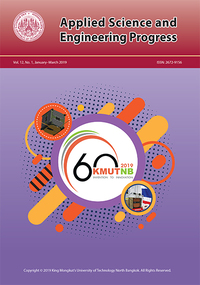Applying the Median and Genetic Algorithm to Construct D- and G-optimal Robust Designs Against Missing Data
Main Article Content
Abstract
In practice, there is a circumstance in which some observed values in well-planned experiments are missing. In this research, small optimal robust response surface designs against missing data were constructed using a Genetic Algorithm (GA) with a Minimum (Min) of alphabetic criteria such as D- and G-optimality for a second-order model. The resulting designs from GA were compared to designs generated from Exchange Algorithm (EA). Unlike EA, GA uses a set of continuous design points as candidate points, so GA produces more optimal and robust designs. For D-optimality, the results showed that the values for D-efficiency, Min D, Med D, and leave- 1-out D criteria of designs generated by GA were all greater than or equal to those from EA. Calculated by EA and GA methods, all G-related criteria values were less than 0.6 apart, except in the case of N = 7. Furthermore, a median of alphabetic optimality criteria has been proposed for use as a criterion to construct robust designs. This approach compromises between optimality criteria such as usual D- and G-optimality and pessimisticoriented criteria such as Min D- and Min G-optimality. For general missing points, the Med D-optimal designs would be superior to the Min D-optimal designs, especially for very small designs. The Med G-optimal designs are far better than the G-optimal designs, although the sample size is increased.
Article Details
References
[2] J. J. Borkowski, “Using a genetic algorithm to generate small exact response surface designs,” Journal of Probability and Statistics Science, vol. 1, no. 1, pp. 65–88, Feb. 2003.
[3] A. Wald, “On the efficient design of statistical investigations,” The Annals of Mathematical Statistics, vol. 14, no. 2, pp. 134–140, Jun. 1943.
[4] E. D. Castillo, Process optimization: A statistical approach. New York: Springer US, 2007.
[5] K. Smith, “On the standard deviations of adjusted and interpolated values of an observed polynomial function and its constants and guidance they give towards a proper choice of distribution of observations,” Biometrika, vol. 12, no. 1/2, pp. 1–85, Nov. 1918.
[6] P. Srisuradetchai, “Robust response surface designs against missing observations,” Ph.D. dissertation, Montana State University, Bozeman, MT, 2015.
[7] J. H. Holland, Adaptation in Natural and Artificial Systems. MA: A Bradford Book, 1992.
[8] Handbook of Genetic Algorithms, 1st ed., New York: Van Nostrand Reinhold, 1991.


